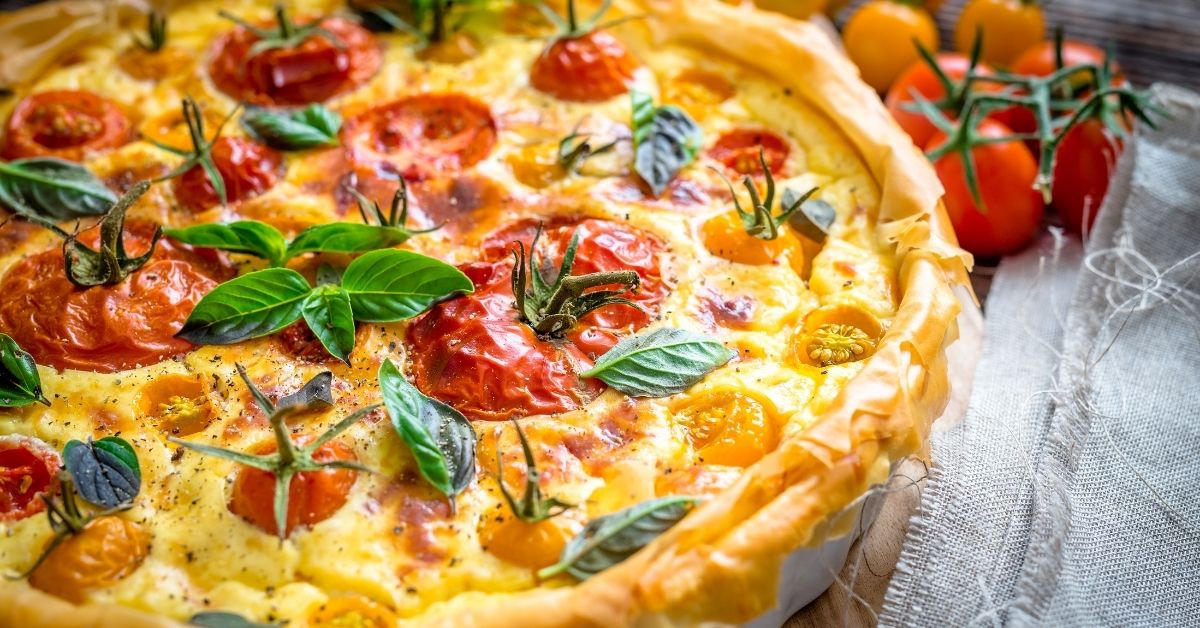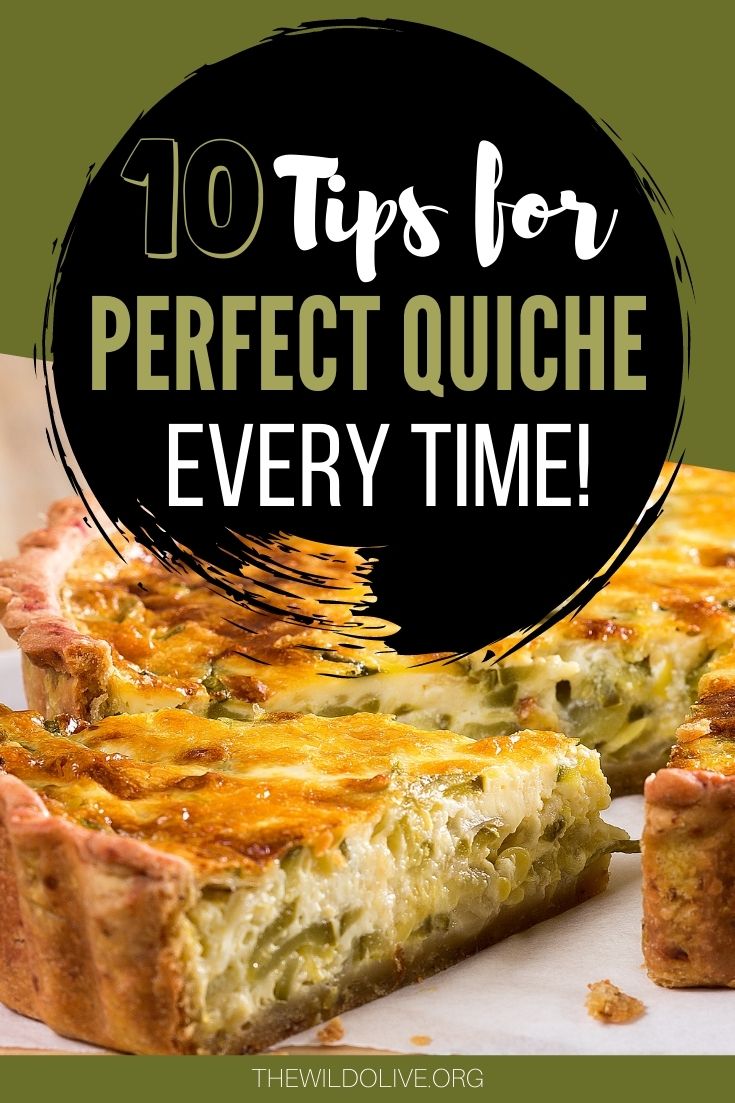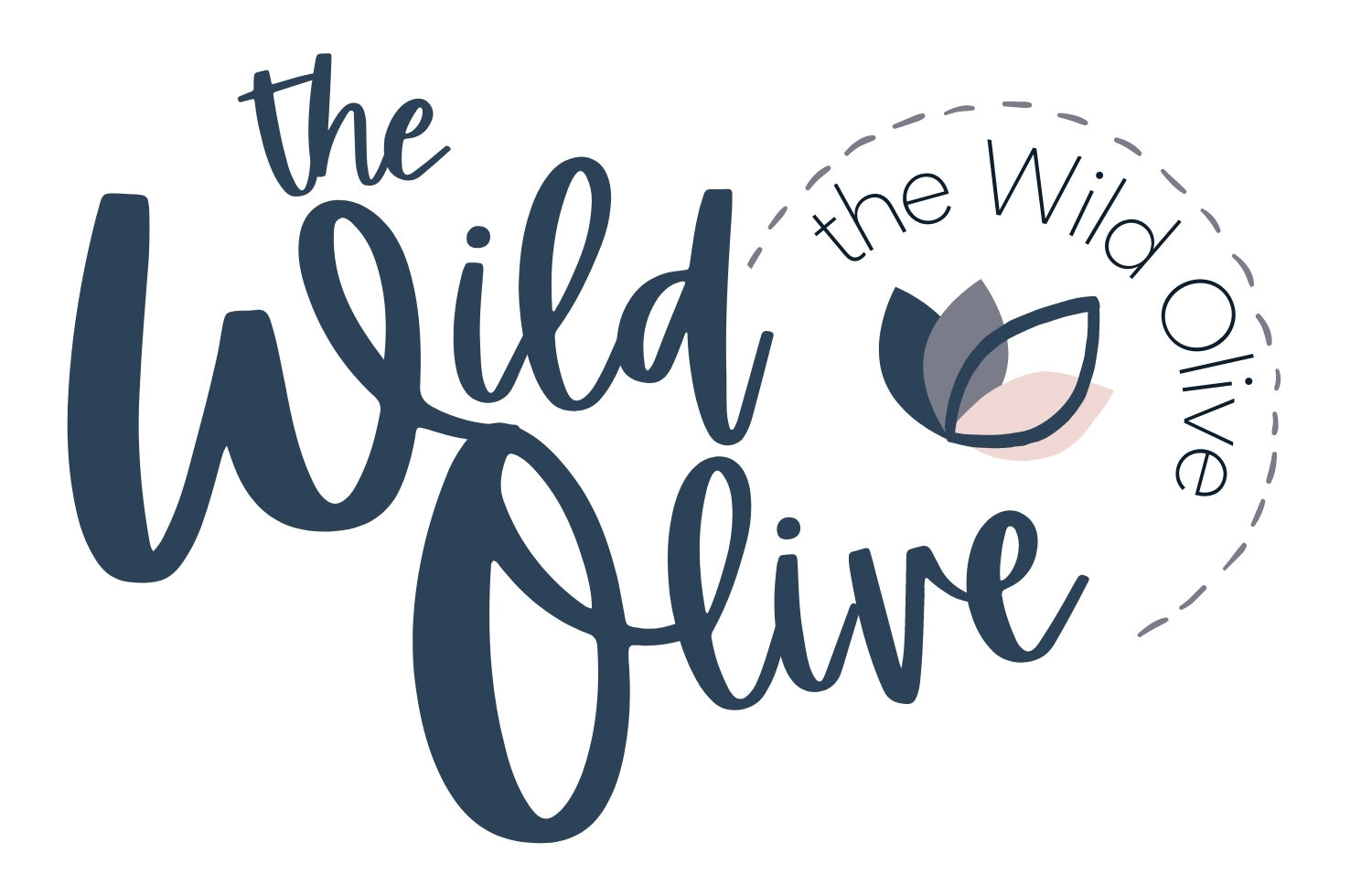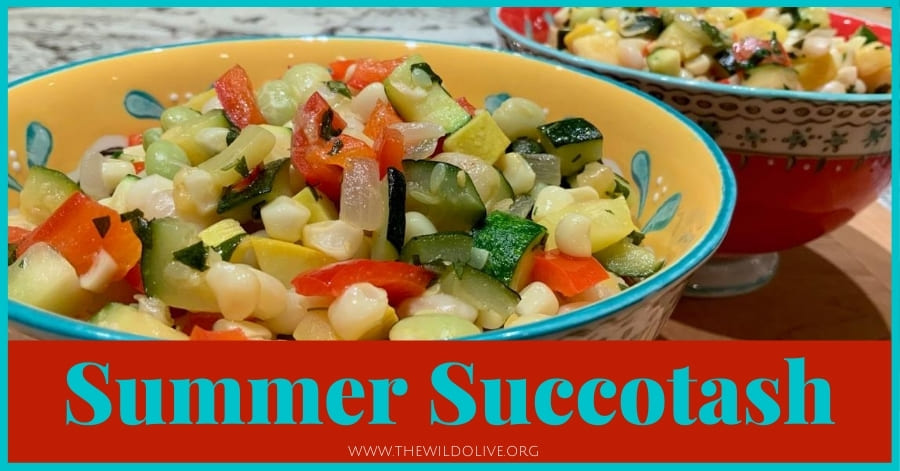How to Bake Perfect Quiche Every Time – 10 Easy Tips
Quiche is such a versatile dish, it’s one every cook should have in her arsenal. It’s one of my favorite ways to repurpose leftovers! However, if you’ve ever made a quiche, you know how easy it is to make a terrible one. With these simple tips, you’ll be able to crank out a perfect quiche every time for quick, easy, and healthy meals. And you won’t have to add gobs of extra cheese or high-fat dairy to do it!

It’s not you – baking a perfect quiche is tricky!
At its heart, a quiche is simply an egg custard – and custards are finicky! Quiche is something that seems so simple, but I bet you’ve made one with:
- a soggy crust
- watery, separated filling that totally collapses when you try to serve it
- filling that’s hard and dry on the edges but soft and wet in the middle
- your custard is perfectly cooked, but your veggies are rock hard
- your veggies are perfectly cooked, but your custard is dry and leathery
- the filling is curdled, clumpy, and totally unappealing.
It’s enough to make you give up entirely on quiche and just make a frittata! 😡 I’ll admit, quiche isn’t one of those things that I actively plan to make. More often it’s something I make when I have bits and bobs of leftovers to use up or I want something hot for dinner but I don’t want to have to work for it. (Seriously, making a perfect quiche should be easy, and with these tips, it will be!)
I’ll share my basic recipe for quiche at the end, but the following tips can be used with any recipe you already have.

10 Tips For Baking a Perfect Quiche Every Time
Tip #1: Ditch the crust
OK, this is an obvious cheat. However, when I make a quiche, 99% of the time I make it without the crust. Even if the crust is store-bought, ditching it saves time, money, and a crazy amount of calories. If you absolutely must have the crust -I hear ya – my advice would be to blind bake it first. The reason soggy crust is such a prevalent issue with quiche is that by the time your crust has gotten nice and brown, your quiche will likely be badly overcooked. If you take the quiche out when the custard is just set, the bottom crust will be doughy.
It’s extremely hard to get a quiche with a browned bottom crust and a perfectly cooked custard. It’s doable, but it’s going to be an extremely high-calorie, high-fat affair, and not a healthy weeknight supper. The obvious solution is to ditch the crust at home and enjoy the full-on experience at your favorite French Bistro (and don’t think about the calories).
Tip #2: Cook your veggies first
One mortal enemy of a stable custard is excess moisture. Excess moisture is one reason why quiches collapse in a watery pool on your plate. Vegetables and meats like ham give off tremendous amounts of water when they’re cooked. Therefore, if you’re using vegetables in your quiche, it’s imperative that you cook them first. Methods like roasting and sauteing are best because they drive off the maximum amount of water while concentrating all that delicious flavor. If you simply must steam your vegetables, pat them in a clean towel afterward to blot up any excess moisture.
Tip #3: Blend your custard instead of whisking it
As we said before, a quiche is basically a custard. Egg custards are a very delicate structure wherein the protein, fat, and liquid are all held in a perfect suspension. When something upsets this balance, you get curdled, clumpy, watery quiche.
A super easy cheat to achieving a stable custard is to use a blender or stick blender (immersion blender) to combine the eggs, dairy and cheese. Don’t overdo it- you don’t want to introduce buckets of air. You just want to whir everything until the cheese almost disappears. 30 seconds max.
Tip #4: Add cream cheese
I recently discovered this little hack. As I said, an egg custard is a very delicate structure. Anything that will help stabilize it is a good thing. Cream cheese adds both a little extra fat (which helps emulsify and stabilize structures) and chemical stabilizers, which, um, stabilize things! The chemical stabilizers that help keep your cream cheese in a nice, neat block will help keep your quiche in nice, neat slices.
Be careful here – you don’t need to add much! In fact, adding too much ends up giving your quiche a weird, cheesecakey flavor. Two to three oz max are all you need. Make sure the cream cheese is super soft by microwaving it for a few seconds. Then blend it in with the dairy, eggs, and cheese.
We’ve tackled one enemy of a creamy, perfect quiche – excess fluid. Now let’s tackle the other – excess heat.
Tip #5: Slow and steady wins the race 🐢
Here’s another reason to ditch the crust. A crust necessitates a higher baking temperature, but high heat almost always equals leathery, over baked custard. The same techniques that ensure a creamy, evenly-baked cheesecake will work on a quiche (they are both egg custards). Think lower temps with a longer bake time. A more gentle temperature like 325 will ensure that by the time the center is fully, and safely set, the edges aren’t dry, leathery, and overdone. If you want to get really fancy, you can bake your quiche in a hot water bath (only if you are going crustless).
Tip #6: Your pan matters
A good quality, heavy glass or ceramic pan is the best vessel in which to bake a crustless quiche. Those materials distribute heat to your quiche more gently and evenly. If you’re baking it in an aluminum pan, or a metal pie plate, you’re begging for a burnt exterior and wibbly-wobbly middle. If you are baking your quiche with a thick, sturdy crust, a heavy gauge spiringform pan or removable bottom tart pan will do nicely.
Alright, we’ve solved the texture problems, now let’s talk about flavor!
First, let me say that Tip #2 is a multitasker. It not only combats wetness it also amps up the flavor. Onions, peppers, and all sorts of other veggies will bring more flavor to the party if you saute or roast them first. This is another reason why quiche is one of my favorite ways to use up leftovers!
Tip #7: Use flavorful cheeses
There’s a reason why cheeses like Gruyere, Swiss, and Fontina are popular in quiche recipes – they pack a lot of flavor! Eggs, milk, and cream are, let’s face it, pretty bland. Unless you’re making a jalapeno and hot sausage quiche, you’re going to want to choose cheeses that both melt well and bring the flavor. My faves to use are Pepper Jack, Habanero Jack, Medium Cheddar, and Sharp Cheddar. Depending on the other ingredients, I sometimes also toss in a sprinkling of BelGioiso’s fabulous Salad Blend (a mix of Asiago, Parm, Romano, and Provolone).
Tip #8: Add seasonings (except salt) to the pan, not the custard.
Don’t blend the herbs or any seasonings other than salt directly into the custard. Instead, place your fillings in the pan, sprinkle on the herbs and seasonings, and then slowly and gently pour over that perfectly blended custard. Why? Seasonings tend to either sink to the bottom or float on the top of the custard, making it very hard to evenly distribute them throughout the pan.
Tip #9: Add a pinch of Nutmeg
And I do mean a tiny pinch. The warm nuttiness of nutmeg plays very well with eggs and just gives the whole dish a little somethin’ somethin’. Works with sweet or savory egg dishes.
And my final tip for perfect quiche every time…
Tip #10: Your patience will be rewarded
When that perfect quiche comes out of the oven, don’t even THINK about cutting into it for at least 20 minutes. If you can wait till it’s closer to room temp, even better. Think of it like cutting into a steak before it’s had time to rest – all the juices come flooding out and you’re left with sub-optimal steak. Give your quiche some time to rest and let the hot custard set up. It’s a bit like pudding here – it will firm up as it cools. You will be rewarded with a creamy, moist quiche that’s soooo much easier to slice and serve. 😁
Make sure you save these tips for later – and please share with your friends!

These tips will work with any recipe you are using – just tweak the method a little to use these techniques. However, as promised, here’s the formula I use when I whip up a quiche for a quick supper:
Basic Crustless Quiche Formula
- 4-5 eggs (however many I need to use up)
- 1 ½ cups dairy – I use what I have on hand, but typically 1 cup milk and ½ cup half and half
- 1 cup shredded cheeses (see Tip #7)
- 1-2 cups add-ins (cooked veggies, meats)
- Seasonings to taste
Preheat oven to 325. Place add-ins and seasonings in a 9″ glass or ceramic pie plate (or other similar sized ceramic baker). Blend eggs, dairy, cheese, and salt to taste. Pour over add-ins in pan. Bake 50-60 minutes or until the top is lightly browned and center is just set. Allow to cool at least 20 minutes before serving.
Here’s another recipe for one of my favorite “leftovers” to use in quiche– Summer Succotash.
Quiche is such a wonderful dish. You can fill it with pretty much anything you have on hand and make it as healthy or as decadent as you like. And it’s a super way to repurpose leftovers into a yummy supper! Once you know the tricks to turning out one that is perfectly baked, creamy, and delicious you’ll be making them all the time. 😁
Peace,


